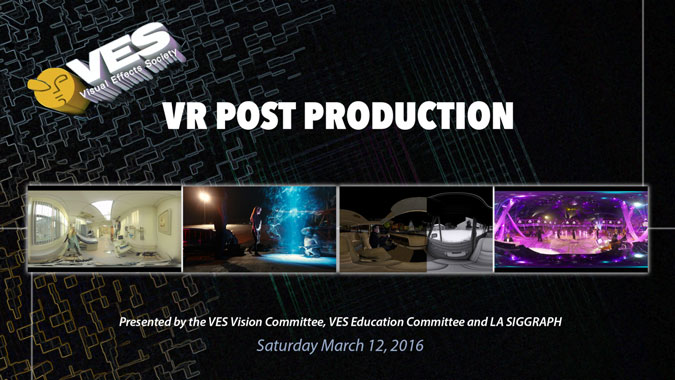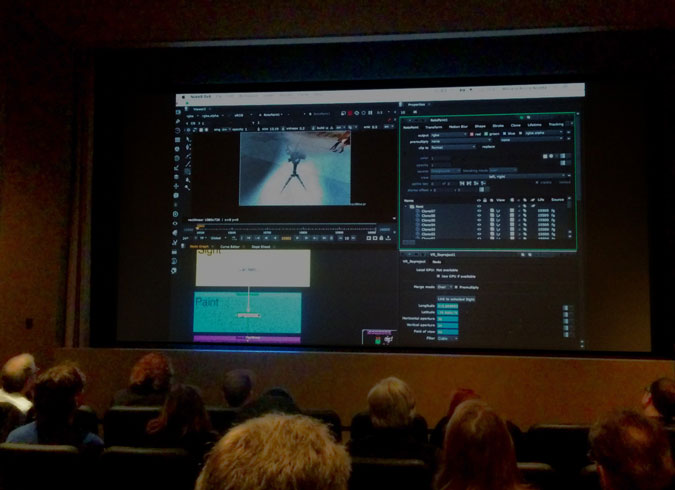VR Post Production with the Visual Effects Society
Virtual Reality is gaining in popularity rapidly and with creative studios starting to develop VR experiences, it’s becoming essential to address the issues that arise when dealing with VR post production. The Visual Effects Society and Siggraph LA organized a VR Post Production event, which was held last week at the Sony Pictures in Culver City, California.
New developments in VR post production are important for Kilograph to be aware of as we forge our path through the world of VR. As a company that is always looking to explore different ways of creating visualizations and telling stories, we need to be at the front line so we always make sure we are exposed to these new developments.

Headquartered in Los Angeles, the Visual Effects Society is the organization that represents digital artists and visual effects technicians within the entertainment industry. It is active in 20 countries and represents more than 2,400 members including artists, animators, technologists,educators, PR/marketing specialists, and producers.
Virtual Reality offers incredible opportunities in storytelling, but its comes with new challenges and new issues at the post-production stage. While VFX artists can still use their skill set and experience, they have to adapt them to different techniques that fit a very new medium.
This exclusive VR Post Production event featured top leaders in the development of virtual reality. It covered the latest VR post production tools that are being used or currently developed. The Foundry’s Media & Production Creative Manager, Mariana Acuña Acosta, presented the VR toolset that is being developed for NUKE and is currently in beta version.
She conducted a demo of this beta version and demonstrated several impressive solutions to prepare 360 footage for VR. The VR plugin addresses a few issues that happen with VR, live action in particular. It helps to stitch all the camera mono and stereo footage as well as correct lens distortion. It also assists with camera rig removal, painting and merging footage with basic tracking.

Looking at the issues we are already facing as we start to undertake more VR projects, we believe at Kilograph that VR tools like this plugin can make our work both higher quality and more efficient. We are now considering how we can integrate these new tools in our pipeline in order to develop best work.
Another part of the event was a screening of the amazing VR film project “Help”, an immersive live action film that was developed uniquely for mobile. It was presented by Gawai Lilliard, VFX supervisor at The Mill, who developed the project in collaboration with Google ATAP. Explaining the methods they used to create this live action VR, Gawai mentioned that a synergy between how you shoot VR and how you do post prod is critical.
Last but not least, we viewed an incredible Goosebumps VR production by MPC and Sony, a horror comedy film adapted into a virtual reality experience. In this experience the viewer is escaping a beast with Jack Black’s character. The idea is to feel as if you are in the movie with the character. The viewer is sitting on the passenger’s seat and is guided by the audio of the character shouting “Don’t look at me, look in front!” or “Where is he?!”, which resolves several issues with storytelling in VR (see our previous blog article focusing on Storytelling in VR).
The audience was widely represented by experienced senior VFX artists, who are exploring the use of virtual reality in their work, and figuring out how to adapt their techniques to this new medium. It was interesting to hear about their perspectives and how elements of the past can help make sense of the questions that arise with VR today. For example, a woman mentioned the use of the multiplane camera that was widely used in the traditional animation process. By moving at different speeds and distances, the camera creates a 3D effect that is similar to what is being sought after in VR.
Interesting, the decision was made to develop a few of the presented projects in actual 3D space rather than with a 360 spherical space. Guest speakers also mentioned the difficulty of using stereoscoping filming and the issues it creates in VR . Most of them recommended filming in monoscopic when creating VR footage, at least at the present moment with where the technology is currently at.
Often and in particular in VR, we look at the future through ideas that already existed in the past.


